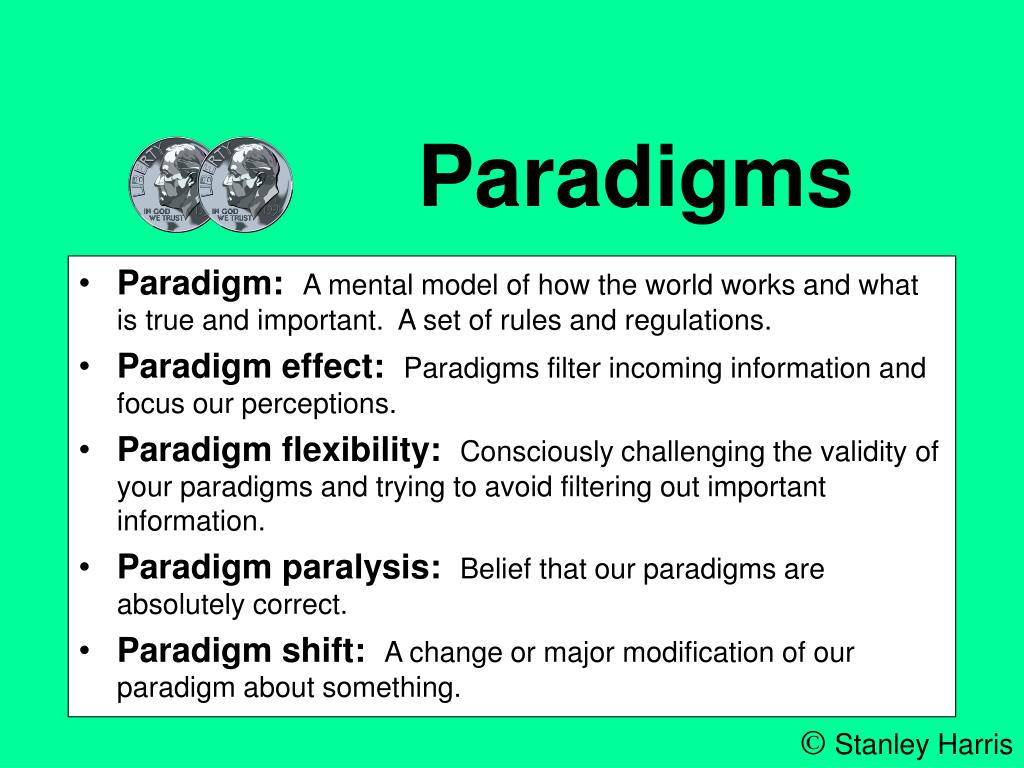

Examples include, “you’ll never amount to much”, “you’re useless at math, why don’t you just give up”. This could be family members, friends, teachers, even the lyrics of songs. Some of these habits serve us, others don’t. Paradigms are created from habits that we gain as we grow up.
#PARADIGM SHIFT DEFINED HOW TO#
Paradigms don’t just happen! They are created, and often at a very young age! Knowing how they are created will give you some clues on how to change them.

Focussing on what you want versus what you don’t want, is also a paradigm. We have a paradigm for jumping out of bed when the alarm goes off or staying in bed and hitting the snooze button! Being motivated or not motivated is also a paradigm. We couldn’t function in life without paradigms! We need paradigms to drive a car, to master a sport or to learn to play the piano or another musical instrument. Your self-image is the internal sense of who you are and your ability to do things. Do you see the world as abundant, beautiful or do you see it as difficult or competitive, like a “dog eat dog” world. Your consistent thoughts, actions and habits can also play a part in reinforcing your current paradigm or forming a new one. This can really hold you back from shifting your paradigm in one or more areas of life. However, if you have a belief that dating is difficult or that all the best people are taken, then this will make it much harder to change this paradigm.Īt a deeper level, you might have beliefs about not being good or worthy enough. Perhaps you would like to make a paradigm shift towards attracting the perfect person into your life, so that you can have a wonderful, beautiful, romantic, and loving relationship. So that belief is going to hold your existing paradigm around money in place. Let’s say you wish to change your paradigm around money, but you have a belief that making money is hard or requires a lot of effort. BeliefsĪnother one is your beliefs about what is possible for you. For example, “I am a calm and relaxed person” or “I am a successful person”, or “I am a person that is good with money”. So you want to change your identity statements so that they are in the positive and towards what you want. If you want to make a paradigm shift towards being calm and relaxed, but you identify yourself as “an anxious person”, then that’s going to create a conflict. For example, “I am a fat and greedy person.”Īll behavior comes from your sense of identity, so if you identify yourself as a fat and greedy person, then it’s going to be harder to change your paradigm to a slimmer person. It’s normally defined using an “I am” statement. This is your sense of who you are in a certain area of your life. Knowing these will make it easier to change them. There are 5 things that tend to keep paradigms in place. Has this happened to you? What Keeps Paradigms in Place? If it goes above, we start to believe that “life can’t be this good”, or “I don’t deserve this”, and we start to self-sabotage. If life falls below this level, we make changes to improve things. We like life to be a certain way that feels comfortable. The same happens subconsciously within us. Think of how the thermostat on a central heating or air-conditioning system keeps the temperature within a precise range. Watch the Video Below:īob Proctor defines a paradigm as “a group of habits that are programmed in your subconscious mind that control your behaviour.”Ī paradigm is a road map of events that have happened in your life and the meaning that you give to them. However, once you learn and apply them, you’ll be on the road to making the paradigm shift in your life that you desire. You can follow these step by step if you wish or take on some and add the others later. I then cover my 7 simple and effective ways to change a paradigm. I’ll also talk about the influence between the conscious and subconscious mind and how that keeps old paradigms in place. It is one or more of these that are behind all the unwanted paradigms in your life. There are 5 components behind any paradigm. I then explain how paradigms are created in the first place. If you want to make a paradigm shift, then you need to know what these are. When you know these, you’ll know why you stay stuck, and why it’s hard to change a paradigm permanently. I will then cover the 5 specific things that keep a paradigm in place. I’ll start by defining what a paradigm is, using definitions from Bob Proctor and others. In this article, you’ll learn 7 simple and powerful ways to change a paradigm.


 0 kommentar(er)
0 kommentar(er)
